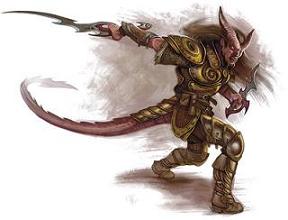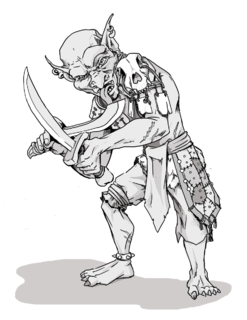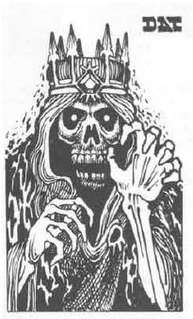
The tiefling is a fictional humanoid race in the Dungeons & Dragons (D&D) fantasy roleplaying game. Originally introduced in the Planescape campaign setting in the second edition of Advanced Dungeons & Dragons, they became one of the primary races available for player characters in the fourth edition of the game.
In the Dungeons & Dragons fantasy tabletop role-playing game, aasimar are a fictional race of humanoid creatures who are descended from celestials, angels and other creatures of good alignment. In the 4th Edition of the game, the equivalent race are referred to as devas.

In the Dungeons & Dragons role-playing game, the kuo-toa are fish-like monstrous humanoids that dwell in the Underdark, and in the sea.
Genasi are creatures in the Dungeons & Dragons fantasy role-playing game.

The yuan-ti are a fictional species of evil snakemen in the fantasy role-playing game Dungeons & Dragons. The species comprises a number of castes. In some campaign settings, the yuan-ti are descended from evil human cultists who mixed their bloodlines with those of serpents. They have formidable psychic abilities.
Eladrin are a fictional race of creatures appearing in the Dungeons & Dragons (D&D) fantasy role-playing game. Introduced in the Planescape setting of AD&D 2nd edition and D&D 3rd edition, Eladrin were described as a type of celestial of chaotic good alignment and hailed from the plane of Arborea. In D&D 4th edition, Eladrin was introduced as a player race and are instead a race of fey beings, closely akin to elves, and associated with the Feywild.

An elf, in the Dungeons & Dragons fantasy role-playing game, is a humanoid race, one of the primary races available for player character. Elves are renowned for their grace and mastery of magic and weapons such as the sword and bow. Becoming physically mature by the age of 25 and emotionally mature at around 125, they are also famously long-lived, capable of living more than half a millennium and remaining physically youthful. Possessed of innate beauty and easy gracefulness, they are viewed as both wondrous and haughty by other races; however, their natural detachment is seen by some as introversion or xenophobia.

In the Dungeons & Dragons roleplaying game, orcs are a primitive race of savage, bestial, barbaric humanoid.

The bugbear is a type of fictional monster in the Dungeons & Dragons fantasy role-playing game.

In the Dungeons & Dragons fantasy role-playing game, goblins are a common and fairly weak race of evil humanoid monsters. Goblins are non-human monsters that low-level player characters often face in combat.
In the Dungeons & Dragons fantasy role-playing game, humanoid is a type of creature, or "creature type". Humanoids are any creature shaped generally like a human, of Small or Medium size. Most humanoids can speak, and usually have well-developed societies.
In the Dungeons & Dragons fantasy role-playing game, undead is a classification of monsters that can be encountered by player characters. Undead creatures are most often once-living creatures, which have been animated by spiritual or supernatural forces.
In the Dungeons & Dragons fantasy role-playing game, an outsider is a type of creature, or "creature type". Outsiders are at least partially composed of the essence of a plane other than the Prime Material Plane.

The lich is an undead creature found in the Dungeons & Dragons (D&D) fantasy role-playing game. Liches are spellcasters who seek to defy death by magical means.

In Dungeons & Dragons, a lycanthrope is a humanoid shapeshifter based on various legends of lycanthropes, werecats, and other such beings. In addition to the werewolf, in Dungeons & Dragons, weretigers, wereboars, werebears and other shapeshifting creatures similar to werewolves and related beings are considered lycanthropes, although traditionally, "lycanthrope" refers to a wolf-human combination exclusively.
In the Dungeons & Dragons fantasy role-playing game, the nightshade is a powerful undead creature composed of darkness and evil.

The halfling is a fictional race found in the Dungeons & Dragons fantasy role-playing game. Halflings are similar to humans, but about half their size. The original Dungeons & Dragons included hobbits, but later the game began using the name "halfling" as an alternative to "hobbit" for legal reasons.

In the fantasy roleplaying game Dungeons & Dragons the cambion is a creature descended from a fiend.
The half-elf is a player character race featured in Dungeons & Dragons and related material.





